Adventures Celebrations of Life Friends & Family
Home Page Living Aboard The Boat
Boot Key Harbor
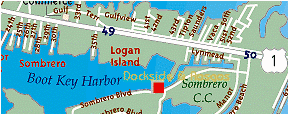
Marathon, Florida Keys
Charmaine's BKH Anchoring article of March 7th 2011 at SSECN www.cruisersnet.net
CAUTION: SEA GRASS BEDS
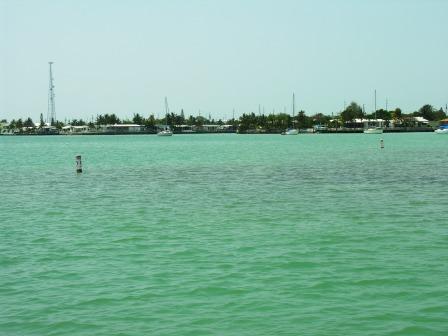
When heading east from beneath the Boot Key Harbor bascule Bridge all is fine as you navigate the channel inside the Harbor. The Harbor, as of summer 2007, has over 250 moorings for public use (hail the City Marina on Channel 16 for an assignment). The problems arise when people don't read their charts and fail to recognize the extensive sea grass area (located immediately southwest of the City Marina) inside the Harbor. This is a protected area and the picture above shows just how shallow... even outside the warning buoys... the area is. That's because Sea Grass Beds GROW. No matter what the charts read, always give sea grass bed a wide berth. Proceed cautiously near them. As the saying goes, "Brown, Brown, YOU'RE AGROUND." Brown water is telling you... it's very shallow over here... keep away!
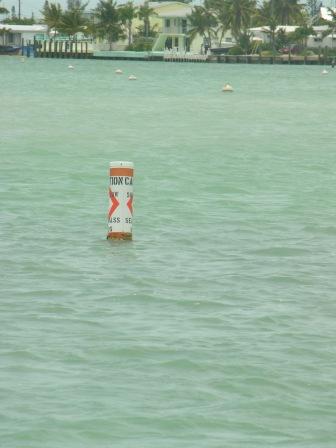
(Note new moorings installed in Boot Key Harbor during Summer 2007. Some are very near the grass beds. Make sure you watch where you are!)
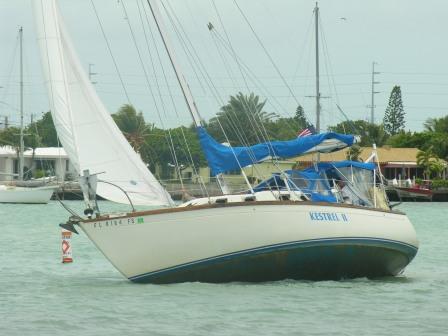
Summer of 2007 saw sailing vessel Kestrel II aground and heeled over (our mooring is right beside the sea grass beds). She got stuck by erroneously sailing inside the buoys which serve to deter boaters from entering the shallow beds inside BKH. Warning buoys actually surround the area, but we have seen many boats aground there. One guy sailed right past the buoy as if it wasn't there. He later said, "Well, it looked like a great place to anchor." As crowded as this Harbor can be... don't you think an expansive area devoid of boats is suspect? Why aren't boats anchored there? Why aren't mooring balls installed there? Because it's too shallow! Duh! In the photo above you can see an outer WARNING buoy on the outside of the vessel's starboard (right) side. BIG OOPS!
It's very important to read your charts and get a feel for any area you're entering no matter where you plan on anchoring (i.e. even when taking a mooring ball). It may be that the bee-line path you take to grab an assigned ball will leave you high and dry atop a sandbar or stuck in the mud aground. Harbors commonly have varying depths (e.g., in Fort Meyers we were on a mooring and told of 7+ feet at all times beneath us (and the charts agreed) yet we sat with a foot of our keel in the mud when at low tide). Once I looked at the chart again I could see how hurricanes had silted in the particular area which was relatively close to an unseen sandbar.
In the Keys it is common to see protected shallow areas. Most of the protected areas don't have warnings. You just have to keep your boat afloat and your prop from damaging sea grass beds. Sea grass beds are the life force by which the majority of marine life is sustained.
Familiarizing oneself with a new area prior to entering is a huge step towards capable sea(wo)manship. The fines for scarring sea grass beds are staggering! Be careful. Read your charts. Stay afloat. And be sure you have tow insurance. One big oops can cost you about $600.00 otherwise. The annual premiums for, let's say, Tow Boat U.S., will run you less than $120.00 and that one premium covers every boat you own.
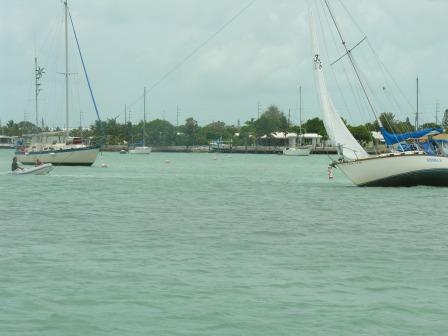
Above: Good Samaritan Sailors in dinghies come to Kestrel II's rescue and try to free her by pulling a halyard (rope attached the mast). By pulling her over to her side, the keel (the weighted ballast beneath the waterline) can be forced out of the bottom to allow water to get beneath it and float the vessel free. I'm sure they were very, very thankful to those who helped them free their vessel. They did minimal damage to the grass beds by NOT trying to power off the bottom. Instead, they relied on assistance from outside the sea grass beds.
Very important! Anyone can be caught in this type of situation. If you cannot wait for tide to come in and float you free, turn off your engine and try to sail off (as the boat here did as well) or kedge off with your dinghy and an anchor if you can. Do NOT try to power off when grounded. You'll do unnecessary damage to the sea grass beds. All professional towing vessels must contact the Coast Guard when they assist someone who has grounded in a protected area.

Here's to staying LOW and WET instead of HIGH and DRY! {Smiles}
March 8th, 2009
Marathon City Marina
Boot Key Harbor - Marathon, FL Keys
Link:
Boot
Key Harbor LIVE WEB CAM
The Marathon City Marina has installed a web cam which pans Boot Key Harbor from
west to east. Check it out at the link above. Awesome!
Even the landscape has changed at the Marathon City Marina. With the addition of
a beautiful tikki hut and stone picnic tables placed in the large area
immediately south of the Marina Office. It's a great place to gather, watch the
sunset, and just kick back and relax!
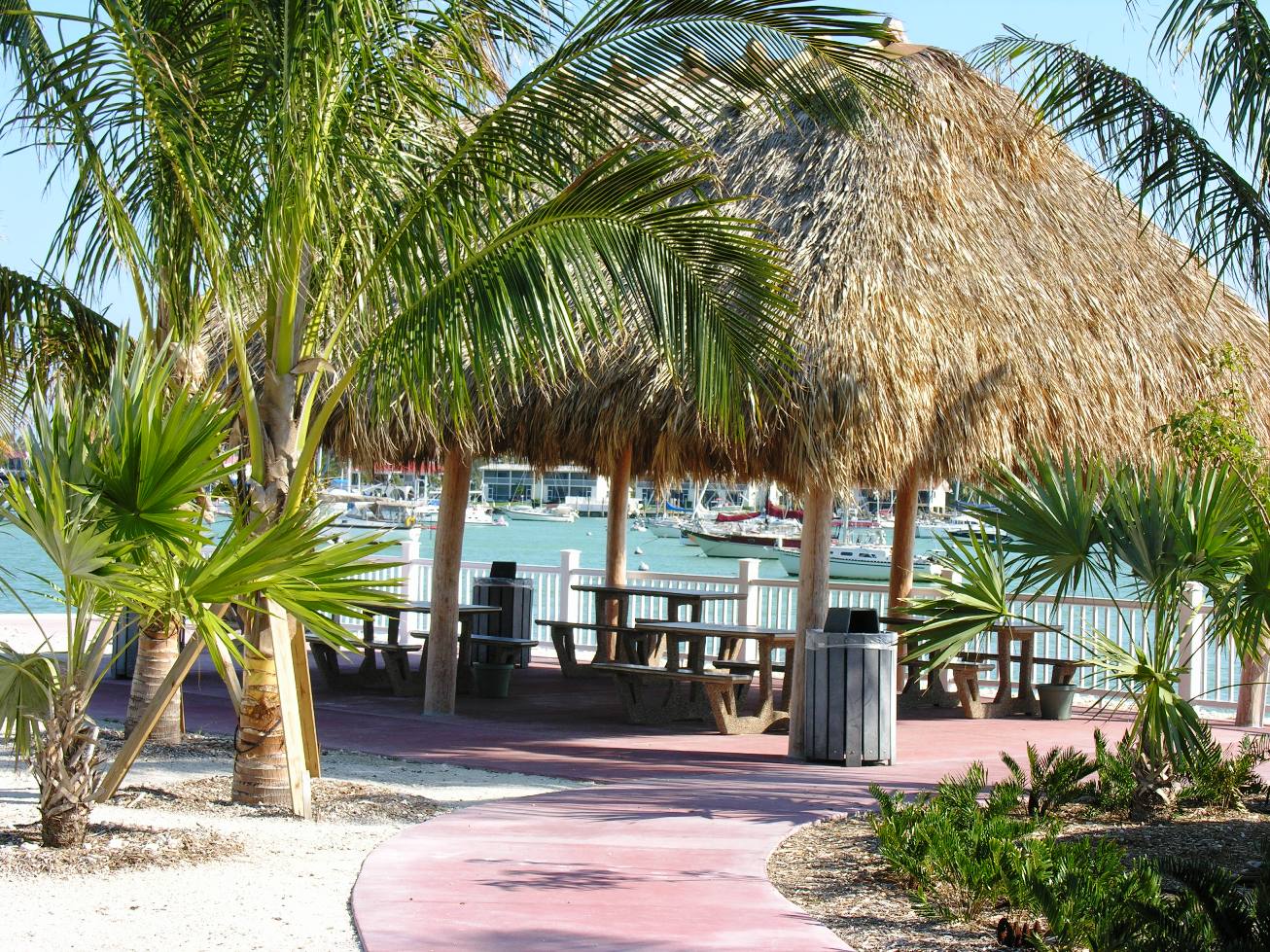
An article is forthcoming right here and at
www.cruisersnet.com on the newest improvements being made by the Marathon
City Marina. I'll be writing about the newest amenities, including a new bath
house, laundry facility with new machines operated by debit card, and an
interview with Harbormaster Richard Tanner on the new, much needed dinghy dock
which will be built in the future. Here on the website, I'll have lots of
pictures to show you what's been going on. Things are looking great!
Yesterday, the crowded existing dinghy dockage at City Marina was improved upon
by removing the T-dock and running it parallel to other dockage. This cleared up
the "bottle neck" at the entrance to the soft dinghy tie-up area and has allowed
quite a bit more room. Whew!
Thank you Marathon City Marina!
Charmaine

Mooring & Anchoring in Boot Key Harbor
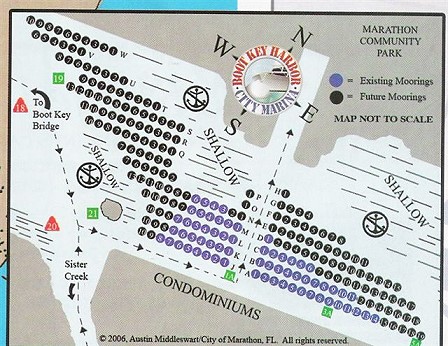
Chart of original mooring balls (blue) & those to be added (black).
April 2007: All moorings have been completed.
The City of Marathon Marina has all moorings charted and their latest publication shows what the new field will look like, along with existing moorings and color indicators showing the new ones to be installed [see above]. It's very simple to pick up a mooring here, if you've acquired one before season. However, once all new moorings are in place, I'd say the long waiting lists will be a thing of the past. They're laid out 75 feet apart, so even the not-so-seasoned sailor can easily grab one. Approach the ball so you're heading into the wind (look to where other boats in that area are pointed) and approach as slowly as possible. I mean SLOW. Barely a crawl. Decide before approaching which side of the boat you want to grab the ball from and have that understood. The person on deck should use hand signals or verbal instructions to the helmsperson. Most of the time people have trouble because they're going much too fast. By the time I've lined myself up with my ball I'm usually in neutral and let the boat glide up to the ball. How much you glide will depend on the wind or current. When done properly you won't even have to go into reverse, but the person on deck has the responsibility to let the helmsperson know to slow down even more if needed to do so. From neutral the ball will be grabbed and the person on deck will let the helmsperson know whether or not to proceed forward or go into reverse so he can hang onto the pennant without it trying to be snatched out of his hands. Everything with regard to mooring balls is SLOW SLOW and SLOWER. (Except you want to quickly get your mooring rode threaded through the pennant, wrapped and secured to a cleat; make sure you run your rode beneath all life lines. You can always make adjustments to to perfection later.)
~~~
I have seen many a woman trying to lean over the bowsprit and grab a mooring ball. Makes no sense to me, that's the highest part of a vessel. Grab the ball with the boat hook from a position that is comfortable. Remember that if you grab the pennant aft of the boat's bow, walk forward with it and go beneath all lifelines then tie it off. Or, even better yet, the female should be at the helm and the male, if more physically adept, should handle grabbing and tying the mooring to the boat. Thread your line through the mooring pennant loop (like threading the eye of an enormous needle). Wrap it around a cleat and hold it taut if you panic. LOL You'll have the helmsperson up there with ya soon to adjust and tie it off properly.
Anchoring in Boot Key Harbor
|
Thursday, April 23rd, 2009
Boot Key Harbor Anchorage
Boot Key Harbor
24°42′23.58″ N
81°5′33.05"
Marathon, FL Keys
by Charmaine Smith Ladd
Boot Key Harbor (BKH) offers the very best protection in all of the
Florida Keys for boats looking to get out of weather. The Harbor is
accessed from the Atlantic by way of two inlets. The west inlet has
a controlling depth of 6 feet. The south inlet, Sister's Creek, has
a controlling depth of just a couple of inches over four feet.
Since the completion of the 226-ball mooring field in
Boot Key Harbor, many have erroneously made the conclusion that
anchorage is no longer available.
Nothing could be further from the truth.
As you pass the permanently upright bascule bridge and enter the
Harbor, you will find the anchorage area begins immediately to your
right (south). The water is relatively much shallower prior to
reaching red marker 16. Deeper water (minimum 7-8+ ft.) is found
just south of the western inlet channel between red markers 16 and
18. The anchorage here is approximately 350 yards in length (west
to east) and about 100 yards wide (south to north). Shallower draft
vessels can anchor beyond the 100 yards nearer to the southern line
of mangroves.
There is also a much smaller, much shallower anchorage located at
the opposite (east) end of Boot Key Harbor. This anchorage is ideal
for multihull vessels and drafts of no more than 3-1/2 feet. There
are some deeper spots in the area, but those are usually taken.
Dinghy dockage is offered by the Marathon City Marina at $13/day,
$43/week, or $127.50/month.
The dinghy fees include trash disposal, the use of the new bathhouse
and adjoining laundry facilities, access to potable water (.05
cents/gallon), and weekly pumpout.
If you are anchoring and don't need shore access often enough to
warrant the City Marina dinghy fees, you can dinghy to the far
eastern end of the Harbor to Hurricane Hole Marina. There they
offer a daily dinghy dockage rate of only $5.00 and are in close
proximity to Publix grocery and other frequented stores. This is
strictly a daily rate and offered as a courtesy as their closeness
to stores is unsurpassed.
So come on down to beautiful Boot Key Harbor where the protection
from winds is as good as it gets, the atmosphere relaxed and laid
back, and the people (boaters and landlubbers alike) are arguably
the friendliest in all of mainland Florida and the Florida Keys.
___________________________________________
Charmaine Smith Ladd, SSECN's Regional Correspondent
for the Florida Keys, bringing you "The Low Down from Down Low."
|
~~~
Anchoring: Using the Bahamian Moor
May 31, 2009
Hi Sam,
Boot Key Harbor seen from our mast while at Sombrero Dockside.
Taken by our son, Bj (Bill Jr.) Ladd (2003).
We spent over four years at marinas in Boot Key Harbor (see below for more about our former marina life). Our goal, all along, was to get out of the marinas and out on our own, whether at anchor or on a mooring, or cruising. The wait was due to broadband internet not being available unless you were connected to a land line; as we were when at our former marinas. Verizon Wireless has high speed, broadband, Kick-Comcast's Ass - high speed internet which allows us to be aboard and work, but not have to have a land line. So we're finally MOBILE!! Woooo Hoooooo!
We absolutely love it out here. The people are wonderful, which we already knew, but it's so much more quiet out here than being surrounded by tourists at marinas. There's pretty much always a breeze out here... and when there isn't, we head outside of the Harbor and drop our anchor where we can get a breeze. We have central air, but I haven't run it yet out here... no need so far. We came out here as of June 1st 2006. Wow, is it fantastic!!
We sold our car, our folding bicycles are aboard, and now we're free as the wind to sail the horizon! Heyyyyyyy!!!
Grocery Shopping & the Dinghy
UPDATE: January 10, 2010
Boot Key Harbor
Hurricane Hole Marina Dinghy Access
No Longer Available due to Construction
Dinghy access to shore via the Hurricane Hole Marina has been discontinued due
to construction at the Marina.
I suspect construction will be ongoing for several months. I'll be sure to post
an update in the future so readers will know if and when access again becomes
available.
Charmaine
February 2009
I wrote an article published at
cruising guide author Claiborne Young's (Salty SouthEast) Cruiser's Net (Cruisersnet.net)
about the fantastic opportunity to dinghy dock at Hurricane Hole Marine for
$5/day. Dockmaster Chris Pitts says this is not to be used for routine dockage,
but offered as a convenience for those wishing to shop at Publix and stores
nearby. Multiple trips on the same day are just fine.
Hurricane Hole Marina is located in the easternmost basin of BKH (formerly a
part of Sombrero Resort). There is a ton of room for dinghies and its close
proximity (Publix is right across the street and many of Marathon's most
frequented businesses are nearby as well) makes the ease of docking there when
time is short or shopping large impossible to beat.
If the Dockmaster is not there, just leave your fee in the till. It might be
wise to write your dinghy registration number on a note with the $5. All
dinghies should be off the dinghy dock by 8:00 pm to discourage misuse (i.e.,
bar hopping).
Charmaine
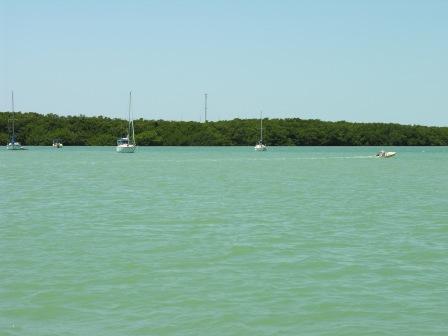
Taken early summer 2007 prior to the additional moorings.
Anchored boats have cleared out and made way.
The areas were cleared where the work was going to be done in phases. When completed, the Harbor will have over 220 moorings. Wow! In the Keys, this is the ONLY protected real Harbor there is. Even the mooring field in Key West cannot compare, as it is not protected. BKH is a true Hurricane Hole as well.
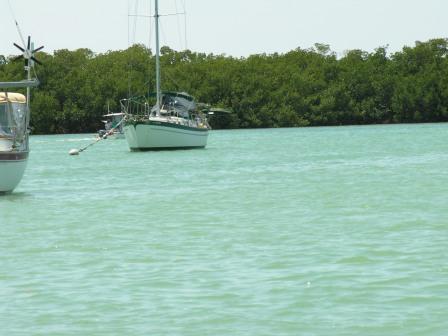
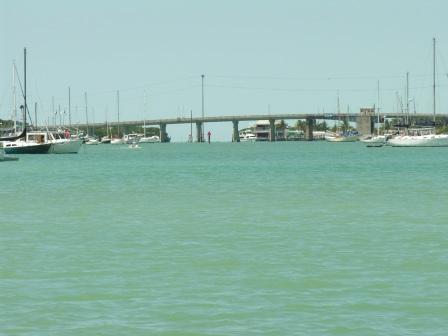
All cleared out and ready for new moorings. Picture taken from the east looking west to Boot Key Harbor Bascule Bridge. Red channel marker on left up near the bridge marks channel. Shown to left is the anchorage area from east to west (to the other side of the bridge).
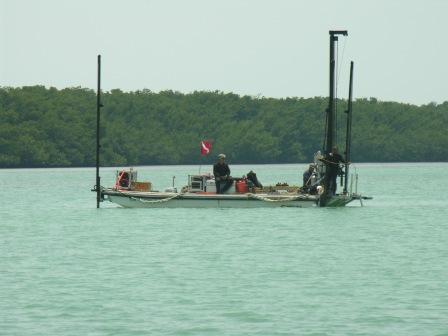
The crew at work installing new moorings.
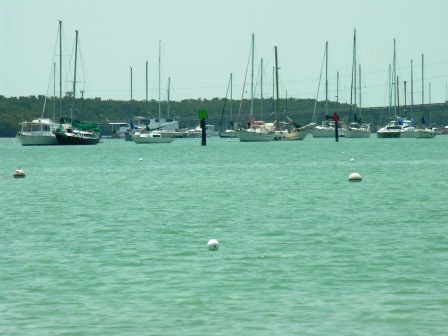
New balls and markers are going in.
Boats shown are in the Boot Key Harbor Anchorage.
One can also anchor outside of the mooring field. You must stay 75 ft. away from the mooring field, 100 ft. away from developed shoreline. If you look at the photo above the mooring field doesn't leave too much room for anchoring. If you have a shallow draft you have many options. It appears that most anchoring will be done in the areas not marked as "Shallow" and where no moorings balls are being installed. That pretty much leaves the area immediately south of the channel (hard right) as you come into the Harbor after passing beneath the Boot Key Harbor Drawbridge. Also, there is still a bit of an anchoring area directly east of the City Marina along the mangroves. But most boats can find they sit on the bottom over there. At the eastern end of the Harbor (north of Dockside) shallower draft vessels can anchor.
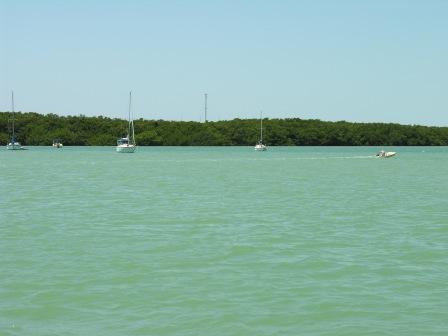
Above: BEFORE new moorings.
Below: AFTER new moorings installed.
Above: Son Bj (Bill Jr.) in Boot Key Harbor (near Marker 5)
the first day he bought this little sailing dinghy in 2003.
BKH Pics
Breighan's friend Ryan watches as Boot Key Bridge opens for s/v September sea. We are headed outbound (West) to open waters. After a day of sailing wherever the wind will take us; we'll return to anchor outside of Boot Key Harbor (outside both Vaca and Boot Keys).
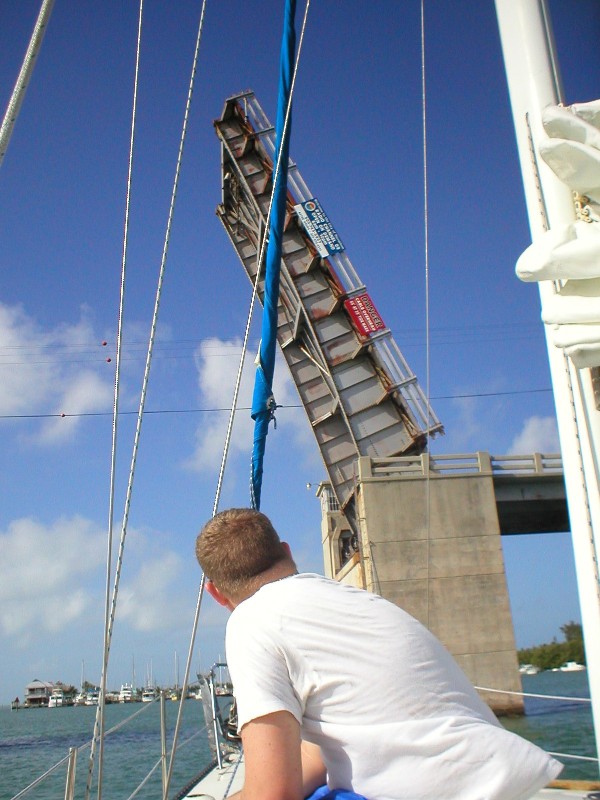
We'll all miss the kind and helpful voices of Boot Key Harbor's famous bridge tenders.
|
ALERT: Boot Key Harbor, Marathon FL
Sunday, January 25th, 2009
by Charmaine Smith Ladd
It's been reported that a boat was dismasted recently after it
was cleared by the Boot Key Harbor (BKH) Bridgetender to pass
through the bascule bridge opening.
The dismasting occurred when the vessel's mast height failed to
clear beneath an overhanging communications line. Fortunately,
there are no power lines of concern.
A vessel with a mast height of 67'1" cleared beneath the
communications line two days ago. Its Captain stated he "waited
for dead low tide"
before doing so.
Deep draft, high-masted vessels navigating Boot Key Harbor,
would be wise to be aware of two things:
1) Enter the mouth (marked channel) of BKH on a rising tide, as
there has been shoaling since Hurricane Wilma of 2005; and
2) When mast height is also a concern (coming in at high tide
can pose a problem clearing beneath the communications line), it
is most often prudent to wait for low tide to ensure mast
clearance.
But wait where?
Proceed east in the marked channel of BKH and make way to the
anchorage area immediately outside the bridge. Drop your anchor
and sit tight until you get the low tide readings necessary for
your mast to pass beneath the
communications line.
When you're ready, hail the Bridgetender on Channel 9 (the
usual channel throughout Florida) and request an opening. Wait
for affirmation and clearance to proceed through.
Never attempt to pass through an opened bridge when you have not
made contact with the Bridgetender. There are often blind spots
caused by the raised bridge. Vessels who try to piggy back
behind another vessel, or those travelling in packs, often
forget they each need to contact the Bridgetender. Vessels have
been dismasted this way as well.
Blind spots or not, it is always proper protocol to request
passage via the Bridgetenders. I might add that the
Bridgetenders of Boot Key Harbor are the friendliest and most
helpful than any you will ever greet. They are the best!
Lastly, as I've reported before, others have put someone up
their mast to push up on the communications line for extra
clearance. Now that the line has even more recently been
cinched, that exercise may no longer be necessary.
Questions, comments or concerns about the bascule bridge and/or
the communications line of Boot Key Harbor?
You can speak directly with a Boot Key Harbor
Bridgetender at: (305) 743-5827.
_________________________________________________________
Charmaine Smith Ladd, SSE Cruiser's Net Regional Reporter for
the Florida Keys, bringing you "The Low Down from Down Low."
|
Our lovely daughter Breighan enjoys being outside the Harbor entrance at anchor.
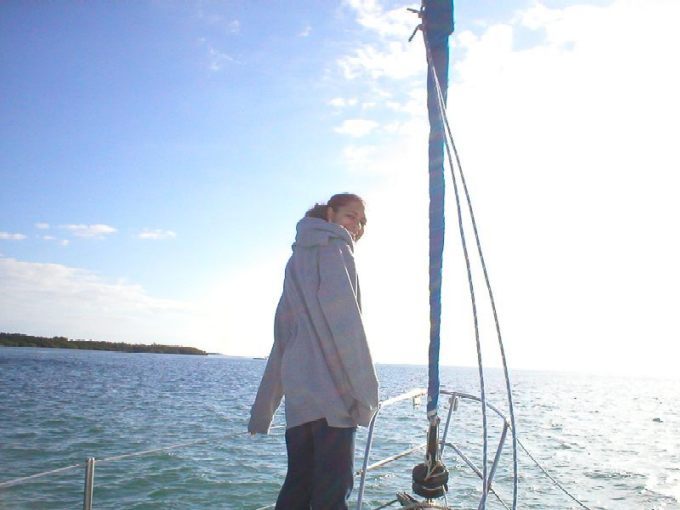
Below, Bj (in hammock) and his father Bill (Bj stands for "Bill Jr.")
chat a bit while anchored outside Boot Key Harbor entrance.
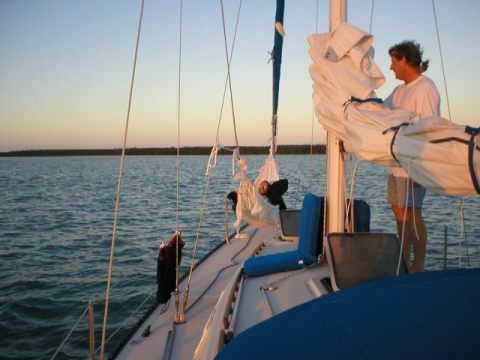
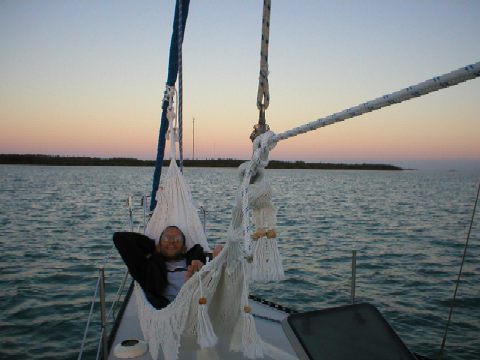
Bj at rest in the hammock, Boot Key in background.
The sun sets with a blast on Boot Key.
"Watching God."
Dedicated to our Beloved Son, Bj.
February 25, 1974 - May 30, 2005
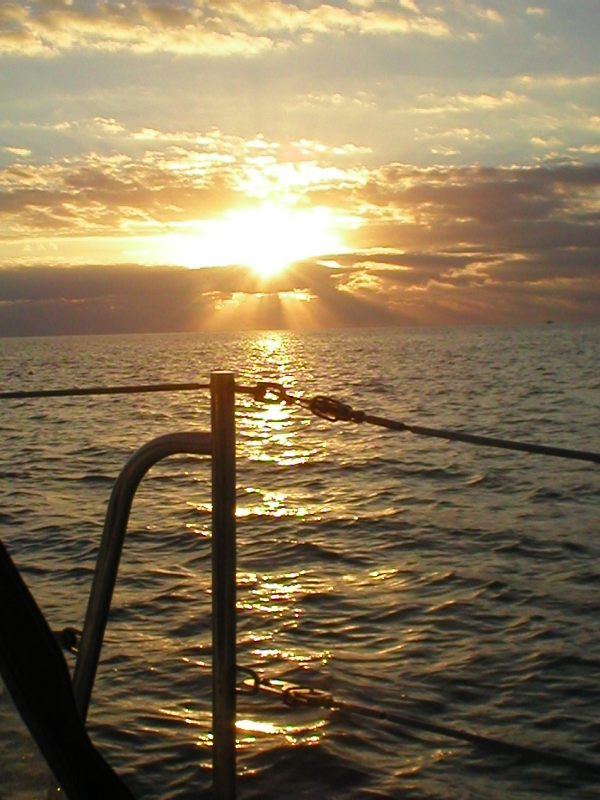
Below, Bj climbs the mast of s/v September Sea.
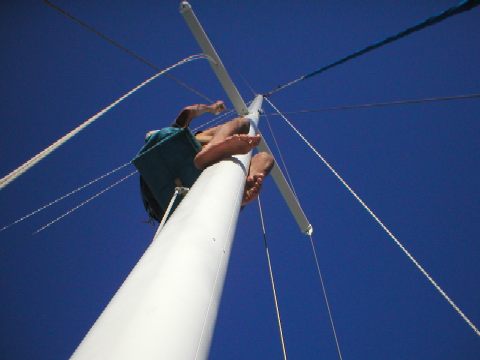
Boot Key Harbor photos as taken by son Bj Ladd from the mast of September Sea.
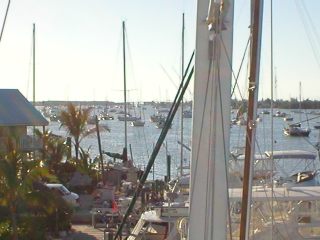
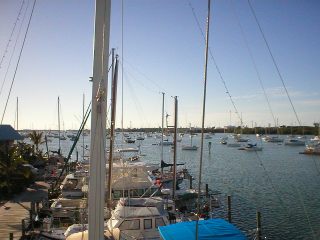
Below: September Sea and crew, daughter Breighan (far left),
Bill standing behind Charmaine (at helm), and son Bj at right; returning to Dockside.
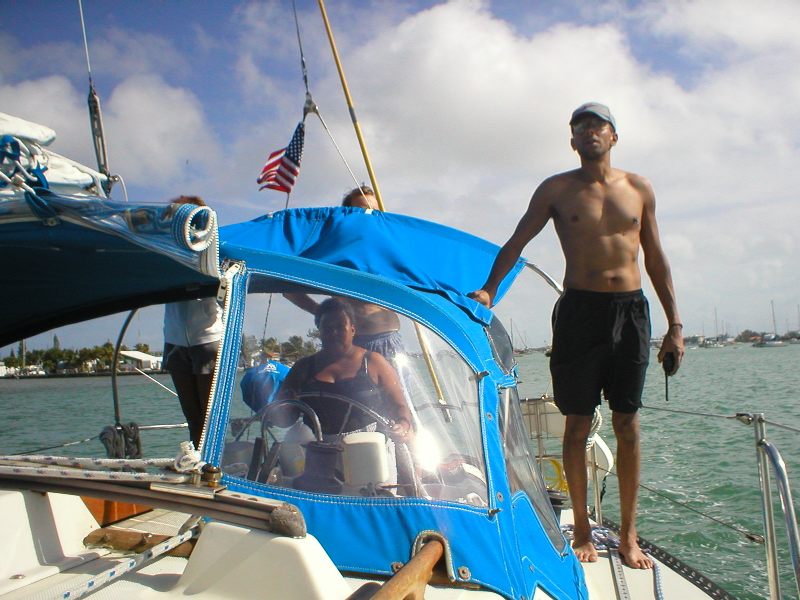
We'll never be a totally complete Ship Smith Ladd again (as we are shown above). No. Not since the loss of our wonderful son, Bj "Bill Junior." Bj left this earthly life after sailing to St. Croix and contracting a flu. Bj had Type 1 (formerly called Juvenile) Diabetes (only 7% of the world's diabetics are Type 1) which put him at high risk throughout his life. He lived a most world traveler and adventurous life despite his condition. He lived his life to its fullest each and every day. Of that we are very proud.
Celebrations of Life and Bj's Eternal Reef are two areas of our site you may want to visit to meet Bj's family and good friends who all came together from around the globe to truly CELEBRATE the life of our truly beloved son. Loved so deeply by so many. We all must remember how very blessed we are to have loved Bj and to have been loved by him in return. Yes, our Nature Boy.
But life goes on despite whom we've loved and lost. Memories, though, especially in this incredible age of technology... are truly forever. Hang in there, good people. Life, even with all the pain it often brings us, could not give us our incredible joys without some risk otherwise. Life, indeed... is risk. Even so, it's a risk we're blessed to experience once again each and every day we awaken from our slumber. Feel or not to feel? Go ahead, pinch me. I can take it. Because the love and the joys of life itself far outweigh the hardships and the pains that crush our hearts. Life is, indeed, death. We cannot have one without the other. Once we understand this concept... then we can stand up to the bad hands life sometimes deals us. We just have to remember ALL the GOOD hands we've had up until now. AND, most importantly, when necessary... put on a dayam good bluff until our hand improves.
Yeah. I'm definitely holding a full house. What you got?